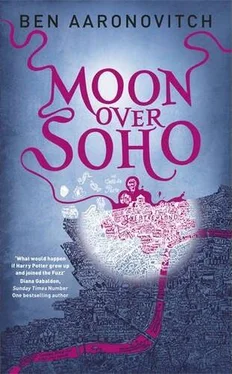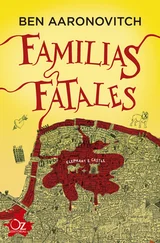“You all right down there, guv?” called a voice from upstairs. The constable with the headscarf — Somali ninja girl.
“I’m going to sort things out upstairs,” said Stephanopoulis. “Will you be okay down here?”
“Yes,” I said. “I’ll be as happy as Larry.”
“Good man,” she said, patted me on the shoulder, and up she went.
“Try and get some lights down here,” I called after her.
“As soon as I can,” she called back.
I kept my torch on and angled slightly downward to give me a reassuring wash of light as far as Larry’s cabinet. Larry’s face, thank God, was reduced to shadow. There was a glint of light from the darkness beyond. I shone my torch and caught a line of bottles along the back of the bar. I thought I heard breathing but when I turned the torch back on Larry both he and his bladders were still.
Nightingale had said not to let anything out. I really wished he hadn’t said that, or at least had said what it was he thought might be in there.
I wondered how long magic could preserve dead flesh. Or had Larry’s head been pickled and stuffed like a hunting trophy? Was there a brain inside? And if there was, how was it being supplied with nutrients? Dr. Walid had once taken cell swabs and blood samples from Nightingale, but they had grown in culture exactly as you’d expect cells from a forty-year-old man to grow. When I asked whether he’d gotten cultures from any of the river gods he laughed and told me that I was welcome to try to obtain some whenever I wanted. Neither of us even considered getting Molly to donate. Dr. Walid’s theory was that, however it worked, it worked at the level of the whole body. So once cells became physically detached from the body they no longer retained whatever quality it was that was keeping them young.
“Or reducing replication errors,” Dr. Walid had said. “Or reversing entropy for all I know. It’s frustrating.”
Ash had been nearly dead when he’d gone into the Thames and now I was reliably informed he was strolling around Chelsea and cutting a swath through the green wellies brigade. Something had repaired the gross tissue damage in his chest and if that was possible for him, then why not Leslie’s face? Maybe she had been right — what magic had done, magic could undo.
I heard a noise from the darkness behind Larry’s cabinet — a scrabbling sound that seemed too regular to be rats. I shone my torch in that direction, but all I caught was a tangle of shadows among the table legs. Larry’s eyes glistened at me — they didn’t look like glass.
I heard the scrabbling again.
I tried my airwave and asked Stephanopoulis whether she had an ETA on Nightingale or even the portable lights. Because it’s a digital system you don’t get the weird atmospherics of an analogue walkie-talkie. Instead, the person you’re talking to drops out at random intervals. I think Stephanopoulis told me that “something” was going to be ten minutes and I was to stay where I was.
Scrabbling.
I took the batteries out of the airwave, turned off my phone, and conjured a nice bright werelight, which I floated off into the foyer beyond Larry’s cabinet. Once you’ve mastered the impello form, you learn to guide whatever it is you’re moving about, but it’s tricky. A bit like operating a remote-controlled plane with your toes. As the werelight curved around the cabinet, I noticed that Larry’s eyes actually moved to follow it. I tried to bring it around in a circle to check, but all I managed was to slow it down and make it wobble. I actually had to close my eyes and concentrate to get the thing to stay. But when I opened them I had my first good look at the foyer.
More of the ubiquitous gold and red flocked wallpaper, and heavy red velvet drapes framing archways farther into the club. Dully gleaming stained pine doors with brass plates marked GENTLEMEN and LADIES on the right. The bar had a mirrored back wall, which meant I could see in the reflection that there was nothing lurking beneath the bar.
My dad had played in clubs that looked like this. I’d gone clubbing in clubs like this, which made me realize how suspiciously unrotten the curtains were — despite the smell of mildew. Then I saw, hanging from a light fitting, the familiar folded-up neon shape of a compact fluorescent low-energy lightbulb — definitely not commercially available in the 1970s. Somebody had been down here recently and often enough to think it worth shelling out for some new bulbs.
This time, when the scrabbling came, I saw movement at the far end of the foyer, where the drapes half hid the archway to the rest of the club. A strange kicking motion in the fabric. I managed to bob my werelight in the right general direction and saw two human legs, probably female, protruding below. They were dressed in stockings — the same rich red color as the wallpaper. And one of the feet was still shod in a matching scarlet pointy-toed stiletto. As my light wobbled closer the legs began to kick, a spastic mechanical movement that reminded me horribly of early biological experiments with frogs. There were no human sounds apart from the heels drumming against the carpet, and the drapes hid anything above the thighs — assuming there was anything above the thighs.
It was possible a human being was in distress, and I had a duty to check it out — if only I could make my feet take a step forward. The legs began to kick more violently and I noticed that my werelight was beginning to dim and take on a redder hue. I was well practiced at werelights by this point, and they never normally changed color without me changing the forma . I’d seen this before when I’d “fed” the ghost of Captain de Vries and my best guess was that as the magic was drained off, the short-wavelength, higher-energy light dropped away first. Although saying that really doesn’t convey how sodding sinister the effect was in real life.
The legs kicked faster, the remaining shoe coming loose and spinning off into the shadows. The light grew dimmer and still I couldn’t make myself go forward.
“Shut it down, Peter,” said Nightingale from behind me. I popped the werelight and immediately the legs stopped kicking. He’d arrived with a bunch of serious-looking forensics people in noddy suits carrying their evidence-collection kits in camera cases. At the back a couple of Murder Team guys, including Somali ninja girl, were wrestling some portable floodlights down the last flight of stairs. Nightingale himself was in a noddy suit, which despite being the most modern item of clothing I’d ever seen him wear still made him look like the lead from a 1950s black-and-white sci-fi classic. He had one of his silver-topped canes in his right hand and a coil of nylon rope slung over his shoulder.
“Do not feed the animals,” he said.
“You think there might be something alive in there?” I asked.
“That’s something we’re going to have to discover for ourselves,” he said.
As the forensics people helped set up the lights, Nightingale stepped into a climber’s harness, attached one end of the rope, and handed the coil to me. He beckoned me closer and spoke quietly so the others wouldn’t hear.
“There’s a possibility there may be booby traps,” he said. “If the rope goes slack, then you use it to haul me out. But under no circumstances are you to follow me in. Anything that is too much for me to handle will utterly destroy you — is that clear?”
“Crystal,” I said.
“There’s also a small chance that something other than me might try to escape out through here,” he said. “It may look somewhat like me, it may even be wearing my body, but I’m counting on you to know the difference. Understand?”
“And if that happens?”
“I’m counting on you to hold it back long enough for the others” — he nodded at the forensics team and other officers — “to escape. Hit it with everything you’ve got, but your best hope will probably be to try to bring the ceiling down on top of it.”
Читать дальше












